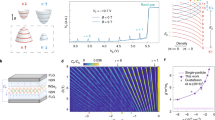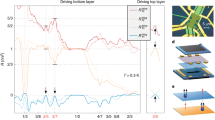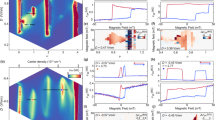Abstract
In monolayer graphene, the two inequivalent sublattices of carbon atoms combine with the electron spin to give electrons a nearly fourfold degenerate internal isospin. At high magnetic fields, the isospin degeneracy increases the already large intrinsic degeneracy of the two-dimensional Landau levels, making low-disorder graphene systems a versatile platform for studying multicomponent quantum magnetism. Here, we describe magnetocapacitance experiments of ultraclean monolayer graphene devices in which a hexagonal boron nitride substrate breaks the symmetry between carbon sublattices. We observe a phase transition in the isospin system, which is marked by unusual transitions in odd-denominator fractional quantum Hall states for filling factors ν near charge neutrality and by the unexpected appearance of incompressible even-denominator fractional quantum Hall states at ν = ±1/2 and ν = ±1/4. We propose a scenario in which the observed states are multicomponent fractional quantum Hall states incorporating correlations between electrons on different carbon sublattices, associated with a quantum Hall analogue of the Néel-to-valence bond solid transition that occurs at charge neutrality.
This is a preview of subscription content, access via your institution
Access options
Access Nature and 54 other Nature Portfolio journals
Get Nature+, our best-value online-access subscription
$29.99 / 30 days
cancel any time
Subscribe to this journal
Receive 12 print issues and online access
$209.00 per year
only $17.42 per issue
Buy this article
- Purchase on Springer Link
- Instant access to full article PDF
Prices may be subject to local taxes which are calculated during checkout





Similar content being viewed by others
Change history
29 October 2018
In the version of this Article originally published, the sketch of ‘PSP’ in Fig. 1a was incorrect; it has now been replaced. Please see the correction note to compare the original and corrected figure.
References
Nomura, K. & MacDonald, A. H. Quantum Hall ferromagnetism in graphene. Phys. Rev. Lett. 96, 256602 (2006).
Checkelsky, J. G., Li, L. & Ong, N. P. Zero-energy state in graphene in a high magnetic field. Phys. Rev. Lett. 100, 206801 (2008).
Zhang, Y. et al. Landau-level splitting in graphene in high magnetic fields. Phys. Rev. Lett. 96, 136806 (2006).
Herbut, I. F. Theory of integer quantum Hall effect in graphene. Phys. Rev. B 75, 165411 (2007).
Nomura, K., Ryu, S. & Lee, D.-H. Field-induced Kosterlitz–Thouless transition in the N = 0 Landau level of graphene. Phys. Rev. Lett. 103, 216801 (2009).
Lee, J. & Sachdev, S. Deconfined criticality in bilayer graphene. Phys. Rev. B 90, 195427 (2014).
Wu, F., Sodemann, I., Araki, Y., MacDonald, A. H. & Jolicoeur, T. SO(5) symmetry in the quantum Hall effect in graphene. Phys. Rev. B 90, 235432 (2014).
Lee, J. & Sachdev, S. Wess–Zumino–Witten terms in graphene Landau levels. Phys. Rev. Lett. 114, 226801 (2015).
Senthil, T., Vishwanath, A., Balents, L., Sachdev, S. & Fisher, M. P. A. Deconfined quantum critical points. Science 303, 1490–1494 (2004).
Zibrov, A. A. et al. Tunable interacting composite fermion phases in a half-filled bilayer-graphene Landau level. Nature 549, 360–364 (2017).
Li, J. I. A. et al. Even denominator fractional quantum Hall states in bilayer graphene. Science 358, 648–652 (2017).
Young, A. F. et al. Tunable symmetry breaking and helical edge transport in a graphene quantum spin Hall state. Nature 505, 528–532 (2014).
Hunt, B. et al. Massive Dirac fermions and Hofstadter butterfly in a van der Waals heterostructure. Science 340, 1427–1430 (2013).
Amet, F., Williams, J. R., Watanabe, K., Taniguchi, T. & Goldhaber-Gordon, D. Insulating behavior at the neutrality point in single-layer graphene. Phys. Rev. Lett. 110, 216601 (2013).
Kharitonov, M. Phase diagram for the v=0 quantum Hall state in monolayer graphene. Phys. Rev. B 85, 155439 (2012).
Kharitonov, M. Canted antiferromagnetic phase of the v = 0 quantum Hall state in bilayer graphene. Phys. Rev. Lett. 109, 046803 (2012).
Sodemann, I. & MacDonald, A. H. Broken SU(4) symmetry and the fractional quantum Hall effect in graphene. Phys. Rev. Lett. 112, 126804 (2014).
Eisenstein, J. P., Pfeiffer, L. N. & West, K. W. Negative compressibility of interacting two-dimensional electron and quasiparticle gases. Phys. Rev. Lett. 68, 674–677 (1992).
Streda, P. Quantised Hall effect in a two-dimensional periodic potential. J. Phys. C 15, L1299–L1303 (1982).
Bolotin, K. I. et al. Ultrahigh electron mobility in suspended graphene. Solid State Commun. 146, 351–355 (2008).
Du, X., Skachko, I., Duerr, F., Luican, A. & Andrei, E. Y. Fractional quantum Hall effect and insulating phase of Dirac electrons in graphene. Nature 462, 192–195 (2009).
Dean, C. R. et al. Multicomponent fractional quantum Hall effect in graphene. Nat. Phys. 7, 693–696 (2011).
Feldman, B. E., Krauss, B., Smet, J. H. & Yacoby, A. Unconventional sequence of fractional quantum Hall states in suspended graphene. Science 337, 1196–1199 (2012).
Feldman, B. E.et al. Fractional quantum Hall phase transitions and four-flux states in graphene. Phys. Rev. Lett. 111, 076802 (2013).
Amet, F. et al. Composite fermions and broken symmetries in graphene. Nat. Commun. 6, 5838 (2015).
Apalkov, V. M. & Chakraborty, T. Fractional quantum Hall states of Dirac electrons in graphene. Phys. Rev. Lett. 97, 126801 (2006).
Tőke, C. & Jain, J. K. Theoretical study of even denominator fractions in graphene: Fermi sea versus paired states of composite fermions. Phys. Rev. B 76, 081403(R) (2007).
Toke, C. & Jain., J. K.. SU(4) composite fermions in graphene: fractional quantum Hall states without analog in GaAs. Phys. Rev. B 75, 245440 (2007).
Shibata, N. & Nomura, K. Fractional quantum Hall effects in graphene and its bilayer. J. Phys. Soc. Jpn 78, 104708–104715 (2009).
Papic, Z., Goerbig, M. O. & Regnault, N. Atypical fractional quantum Hall effect in graphene at filling factor 1/3. Phys. Rev. Lett. 105, 176802 (2010).
Toke, C. & Jain, J. K. Multi-component fractional quantum Hall states in graphene: SU(4) versus SU(2). J. Phys. Condens. Matter 24, 235601 (2011).
Papic, Z., Thomale, R. & Abanin, D. A. Tunable electron interactions and fractional quantum Hall states in graphene. Phys. Rev. Lett. 107, 176602 (2011).
Peterson, M. R. & Nayak, C. Effects of Landau level mixing on the fractional quantum Hall effect in monolayer graphene. Phys. Rev. Lett. 113, 086401 (2014).
Willett, R. et al. Observation of an even-denominator quantum number in the fractional quantum Hall effect. Phys. Rev. Lett. 59, 1776–1779 (1987).
Falson, J. et al. Even-denominator fractional quantum Hall physics in ZnO. Nat. Phys. 11, 347–351 (2015).
Ki, D.-K., Fal’ko, V. I., Abanin, D. A. & Morpurgo, A. F. Observation of even denominator fractional quantum Hall effect in suspended bilayer graphene. Nano Lett. 14, 2135–2139 (2014).
Abanin, D. A., Skachko, I., Du, X., Andrei, E. Y. & Levitov, L. S. Fractional quantum Hall effect in suspended graphene: transport coefficients and electron interaction strength. Phys. Rev. B 81, 115410 (2010).
Halperin, B. I. Theory of the quantized Hall conductance. Helv. Phys. Acta 56, 75–102 (1983).
Suen, Y. W., Engel, L. W., Santos, M. B., Shayegan, M. & Tsui, D. C. Observation of a v = 1/2 fractional quantum Hall state in a double-layer electron system. Phys. Rev. Lett. 68, 1379–1382 (1992).
Eisenstein, J. P., Boebinger, G. S., Pfeiffer, L. N., West, K. W. & He, S. New fractional quantum Hall state in double-layer two-dimensional electron systems. Phys. Rev. Lett. 68, 1383–1386 (1992).
Liu, Y. et al. Even-denominator fractional quantum Hall effect at a Landau level crossing. Phys. Rev. B 89, 165313 (2014).
Liu, Y. et al. Fractional quantum Hall effect at v = 1/2 in hole systems confined to GaAs quantum wells. Phys. Rev. Lett. 112, 046804 (2014).
Luhman, D. R. et al. Observation of a fractional quantum Hall state at v = 1/4 in a wide GaAs quantum well. Phys. Rev. Lett. 101, 266804 (2008).
Shabani, J., Gokmen, T., Chiu, Y. T. & Shayegan, M. Evidence for developing fractional quantum Hall states at even denominator 1/2 and 1/4 fillings in asymmetric wide quantum wells. Phys. Rev. Lett. 103, 256802 (2009).
Alicea, J. & Fisher, M. P. A. Graphene integer quantum Hall effect in the ferromagnetic and paramagnetic regimes. Phys. Rev. B 74, 075422 (2006).
Du, R. R. et al. Fractional quantum Hall effect around v = 3/2: composite fermions with a spin. Phys. Rev. Lett. 75, 3926–3929 (1995).
Balram, A. C., Toke, C., Wojs, A. & Jain, J. K. Phase diagram of fractional quantum Hall effect of composite fermions in multicomponent systems. Phys. Rev. B 91, 045109 (2015).
Abanin, D. A., Feldman, B. E., Yacoby, A. & Halperin, B. I. Fractional and integer quantum Hall effects in the zeroth Landau level in graphene. Phys. Rev. B 88, 115407 (2013).
Pientka, F., Waissman, J., Kim, P. & Halperin, B. I. Thermal transport signatures of broken-symmetry phases in graphene. Phys. Rev. Lett. 119, 027601 (2017).
Wei, Di. S. et al. Electrical generation and detection of spin waves in a quantum Hall ferromagnet. Preprint at http://arXiv.org/abs/1801.08534 (2018).
Wang, L. et al. One-dimensional electrical contact to a two-dimensional material. Science 342, 614–617 (2013).
Goodall, R. K., Higgins, R. J. & Harrang, J. P. Capacitance measurements of a quantized two-dimensional electron gas in the regime of the quantum Hall effect. Phys. Rev. B 31, 6597–6608 (1985).
Acknowledgements
We acknowledge discussions with D. Abanin, G. Murthy, Z. Papic, I. Sodemann and M. Zaletel and the experimental assistance of S. Hannahs. Magnetocapacitance measurements were funded by the National Science Foundation under DMR-1654186. A portion of the nanofabrication and transport measurements were funded by Army Research Office under proposal 69188PHH. A.F.Y. acknowledges the support of the David and Lucile Packard Foundation. E.M.S. acknowledges the support of the Elings Prize Fellowship in Science of the California Nanosystems Institute at the University of California, Santa Barbara (UCSB). The research reported here made use of shared facilities of the UCSB Materials Research Science and Engineering Center (NSF DMR 1720256), a member of the Materials Research Facilities Network (www.mrfn.org). Measurements above 14 T were performed at the National High Magnetic Field Laboratory, which is supported by National Science Foundation Cooperative agreement no. DMR-1157490 and the State of Florida. K.W. and T.T. acknowledge support from the Elemental Strategy Initiative conducted by the Ministry of Education, Culture, Sports, Science and Technology, Japan, and the Japan Society for the Promotion of Science KAKENHI grant no. JP15K21722.
Author information
Authors and Affiliations
Contributions
E.M.S. fabricated devices A, B and C, and H.Z. fabricated device D.T.T. and K.W. synthesized the hexagonal boron nitride crystals. A.F.Y. and C.K. built the measurement electronics. A.A.Z., E.M.S. and A.F.Y. acquired and analysed the experimental data. A.A.Z., E.M.S. and A.F.Y. wrote the paper.
Corresponding author
Ethics declarations
Competing interests
The authors declare no competing interests.
Additional information
Publisher’s note: Springer Nature remains neutral with regard to jurisdictional claims in published maps and institutional affiliations.
Supplementary information
Supplementary information
Supplementary figures S1–S18
Rights and permissions
About this article
Cite this article
Zibrov, A.A., Spanton, E.M., Zhou, H. et al. Even-denominator fractional quantum Hall states at an isospin transition in monolayer graphene. Nature Phys 14, 930–935 (2018). https://doi.org/10.1038/s41567-018-0190-0
Received:
Accepted:
Published:
Issue Date:
DOI: https://doi.org/10.1038/s41567-018-0190-0
This article is cited by
-
Quasi-one-dimensional transport in graphene under a magnetic field
Journal of the Korean Physical Society (2024)
-
Imaging field-tuned quantum Hall broken-symmetry orders and the quantum Hall conducting channel in a charge-neutral graphene/WSe2 heterostructure
Science China Physics, Mechanics & Astronomy (2023)
-
An atomistic approach for the structural and electronic properties of twisted bilayer graphene-boron nitride heterostructures
npj Computational Materials (2022)
-
Large magnetocapacitance beyond 420% in epitaxial magnetic tunnel junctions with an MgAl2O4 barrier
Scientific Reports (2022)
-
A tunable Fabry–Pérot quantum Hall interferometer in graphene
Nature Nanotechnology (2021)



